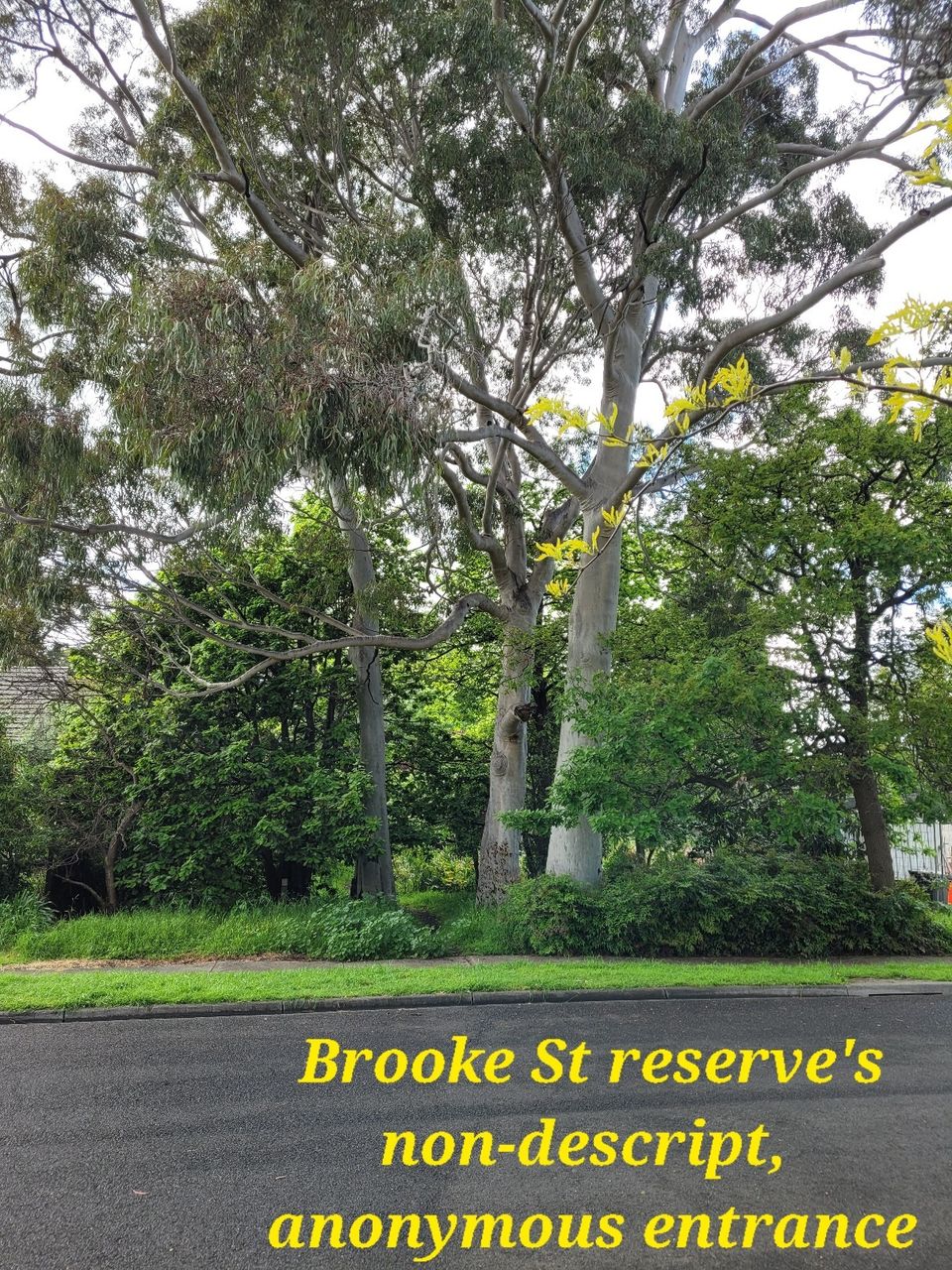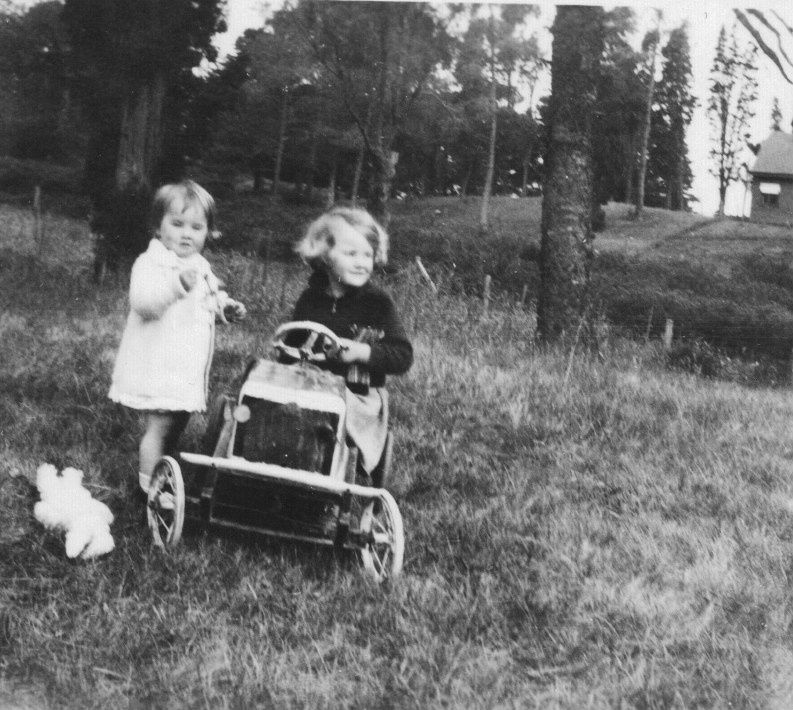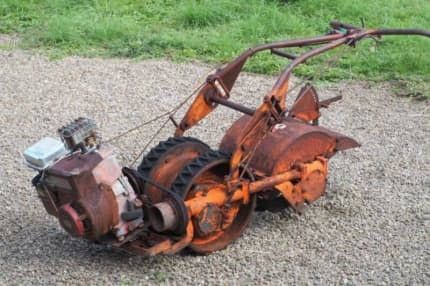Mr Brooke of Brooke Street

Tucked away up on Mt Eagle, near the Maltravers Road end of the ridge, is the Brooke Street Reserve.
It is named after J. H. Brooke, who made a good start to creating a fine estate........
Leader, 22.08.1874, Page 9
MOUNT EAGLE.
A visit to the grounds laid out and planted by Mr. Brooke, at Mount Eagle, near Heidelberg, recalls with vivid force some of the finest of English scenery. Being situated on the summit of a hill, a magnificent view can be obtained of the beautiful undulating ground in the vicinity, the fertile valley of the Yarra, and the far distant mountains of Gipps Land.
MEMORIES OF HEIDELBERG
(Sourced by Nilss,)
Leader, 19.05.1900
The Mount Eagle property did not long remain in Mr. Mitchell's hands, the next owner being Mr. John Henry Brooke, who was Minister of Lands in the Heales Government, 1860-61. He at once began to improve the place by an extensive system of tree planting, employing a good practical gardener, who, by means of a hot house and garden frames, propagated seeds imported by Mr. Brooks from various countries, and planted out the young trees all over the estate.
These trees, now upwards of 40 years old, form a magnificent plantation, with winding avenues and picturesque glades, and seen from the road or railway make a solid mass of dark green, very restful to the eyes among the surrounding fields of parched yellow grass.
It was Mr. Brooke's intention to build a mansion on the summit of Mount Eagle, where at first he lived in a tent with his wife and two daughters.
The timber for flooring was brought on the ground, and with this a temporary house was put up, the boards being placed perpendicularly instead of in weatherboard fashion.
The projected mansion, however, was never built, for Mr. Brooke, having lost his seat in Parliament, emigrated with his family to Japan.
Mount Eagle belonged to the late Sir Samuel Wilson for many years, and in 1888 was purchased by the Eaglemont Estate Company Proprietary Limited. The company held it for a short time, until by arrangement it reverted to private ownership.
The old house, some 10 or 12 years ago, was much frequented by artists, and was the scene of many a picnic, afternoon tea and impromptu dances.
Just incredible that 161 years ago there was already established on Mt. Eagle an arboretum worthy of a visit from a gardening journal.
The Farmer‘s Journal and Gardener‘s Chronicle, 19.07.1862, Page 12
THE GROUNDS AT MOUNT EAGLE, HEIDELBERG.
The frequency of useful and ornamental exhibits, emanating from the above source, at the Horticultural Improvement Society’s monthly meetings, has induced us to pay a special visit, in order more particularly to report upon the success or otherwise that has attended the planting of coniferous trees and shrubs in the above-named locality. It is, perhaps, well known, that Mount Eagle is the residence of J. H. Brooke, Esq., M.L.A., with whom the introduction and cultivation of rare and beautiful trees has been a favorite pursuit; and in this he has found a warm supporter in his gardener, Mr Wm. Ferguson, to whose talents and horticultural skill the success of the operations is undoubtedly due. The estate at Mount Eagle comprises a great variety of hill and dale, and is therefore capable, under judicious management, of being made eminently picturesque.
Our subscriber John of Warrandyte North was a childhood resident of Brooke Street, Eaglemont.
He penned a note to us, gently admonishing our ignorance of Brooke Street Reserve's importance in local history.
He enclosed a couple of family snaps taken in the Reserve, but sadly no photo of Sooty the blackberry eating goat.

[This is a (hasty) compilation of material supplied by former Brooke Street Eaglemont resident John Anderson. It is a rich vein of local social history.]
Brooke Street Reserve
So the latest FofEV Newsletter asks, “Who ever heard of Brooke Street Reserve?” What crass igorance (note spelling).
When I was a kid in the 1940s “The Reserve” was the centre of the universe. Our home at 16 Brooke St, which in those days was a modest single storey house without a driveway let alone a car, adjoined the northern side of the reserve and our activities after school naturally gravitated to the reserve.

We built bonfires, made cubby houses on the ground and in the trees, suspended ropes from the Douglas fir tree on the hill so that we could swing down the hill over a high jump, and when it rained built dams and channels in the water course which we would suddenly demolish to release great torrents of water.
The subdivision atop the Eaglemont hill was one of his first designed by Walter Burley Griffin before he embarked on his more extensive and better-known projects such as the layout of Canberra and Griffith (NSW).
His designs are distinguished by sweeping curved streets (e.g. Glen Drive, Outlook Drive) to blend with the environment and the creation of community reserves for people to gather and recreate.
The Brooke St Reserve is one of these and is sited along a natural shallow drainage line that was used to direct run-off water from Glen Drive and elsewhere into the main drain that runs down the gully in the dips in Ormond Rd, The Righi and so on. When it was first built, the run-off water from Glen Drive used to run as an open watercourse through the Brooke St Reserve.

The vegetation in the reserve was a terrible mishmash. The indigenous plants included a grand old yellow box, a graceful weeping Casuarina and several species of acacia including quite dense thickets of very spiny A. paradoxa.
Like so much of the former Eaglemont estate, the reserve contained various introduced trees including several large specimens of cluster pine (Pinus pinaster) that provided us with pinecones for lighting our briquette hot water service, and a few cypress trees.
Several mature golden willows and a pussy willow grew along the watercourse at the Glen Drive end and a cluster of weeping willows that often showed signs of water stress in the summer occurred in the middle section which was an environmental disgrace – choked with honeysuckle, blackberries and impenetrable stands of prickly gorse.
Moreover, certain residents with little environmental conscience (they did not live in Brooke St!) used the middle section for dumping rubbish – much of it non-combustible.
These conditions made the reserve a good habitat for snakes and I remember the occasion when our good neighbour at 18 Brooke St, Mr Alan Nash, was bitten by a tiger snake when watering his garden at dusk. He was rushed off to hospital where he was probably treated with tiger snake anti-venom (my dad used to be involved in producing the stuff from the serum of horses treated with controlled amounts of venom milked from tiger snakes) and made a good recovery.
Next day the men of Brooke St got together and combed the reserve with rakes and shovels and set fire to any thickets. They proudly emerged with their quarry, which although well armed was no match for a troupe of good Brooke St men determined to protect their families.
As time went by, the residents took an increasing interest in beautifying the reserve. One of the first steps in this direction came when we acquired a nanny goat called Sooty; we used to tether her in the reserve within range of the blackberries before heading off to school. She soon had the blackberries in check.
Then we kids were encouraged to remove the gorse by going in bum first with a hessian sack tied around our middle to grub out the offending material with a mattock.
Our reward was that they made a spectacular blaze on our bonfires on Empire Day, Queens Birthday and the like.
Then our family bought an auto scythe attachment for our little Bantam rotary hoe – a wickedly dangerous device that made short work of the long grass and any regrowth of blackberries and honeysuckle.

Then the Moore family at No 14 Brooke St did a great job in clearing and replanting the Brooke St end of the reserve and made it very attractive.
Some time later, after I had left home, Heidelberg Council constructed a pipeline down the length of the reserve to take the runoff water from Glen Drive. This greatly simplified the management and maintenance of this historically important feature, bequeathed to the people of Eaglemont by that great master of town planning, Walter Burley Griffin.
Member discussion